Free US Shipping On Orders Over $49
Easy 30-Day Returns
Financing Available Through ![]()
Free US Shipping On Orders Over $49
Easy 30-Day Returns
Financing Available Through ![]()

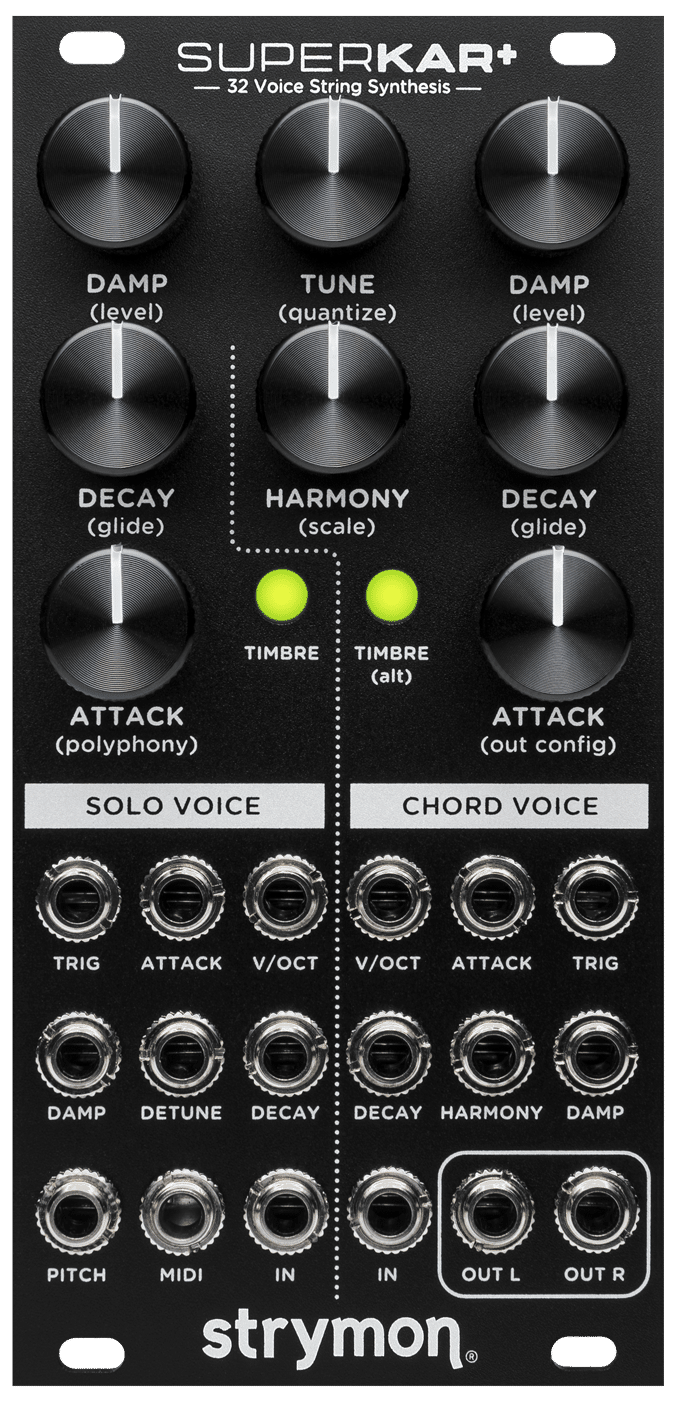
$399.00
Availability: In stock.
Ships same day, or next business day.
-
SuperKar+ is a Eurorack voice module that uses Karplus-Strong synthesis to create the sound of plucked or bowed strings, struck or blown pipes or tubes, or a suite of other sounds from percussive textures to legato melodies and chords with smart harmonies. This is Karplus-Strong synthesis at its most intuitive and captivating.
Karplus-Strong is a form of delay feedback synthesis, where every tone and texture is constantly in a state of varying tension. SuperKar+ is an engagingly responsive instrument, as tiny changes in attack/decay time and damping create an infinite variety of subtle or dramatic timbral shifts, and variable random per-note detuning can create lifelike realism.
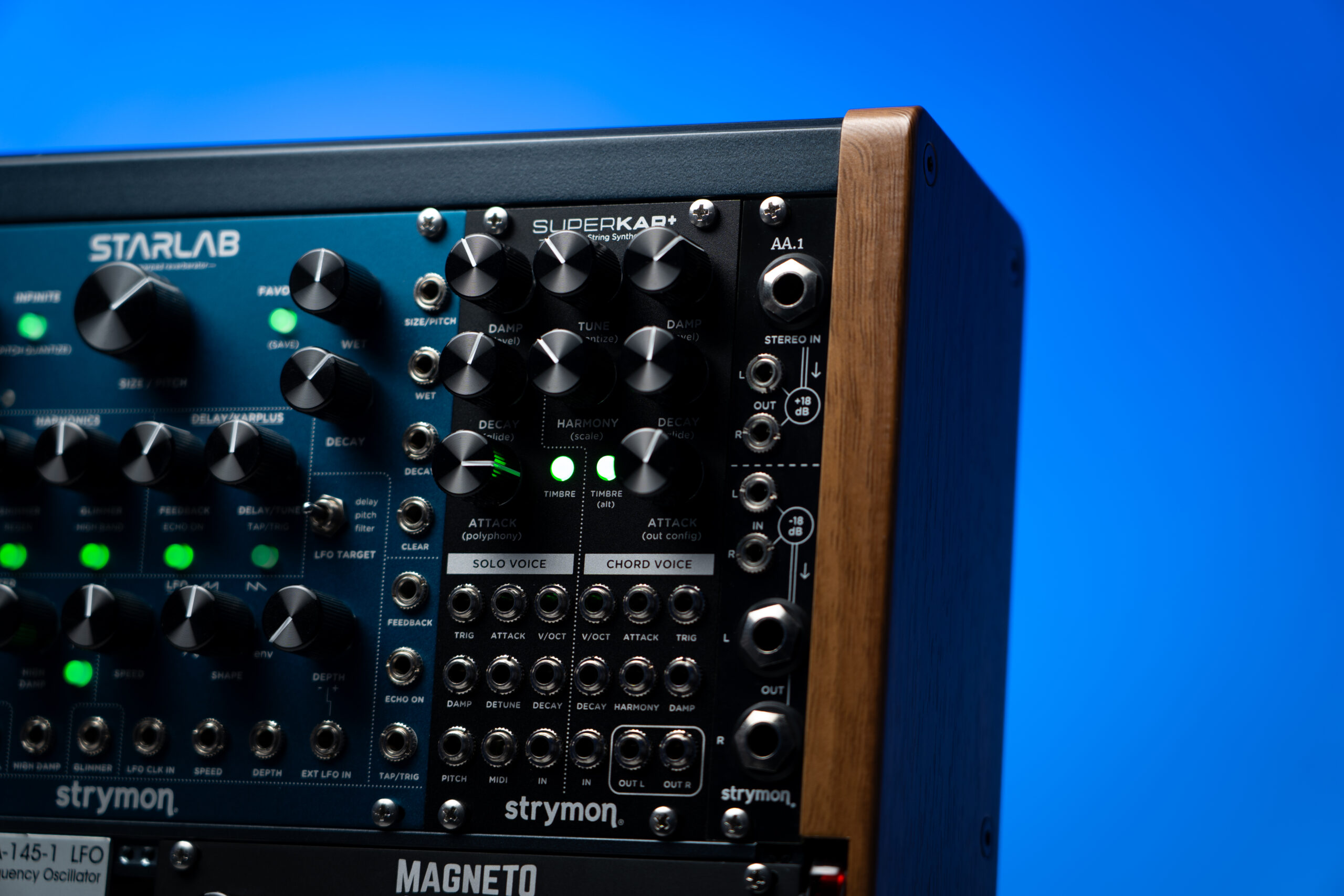
With an interface that can be understood at a glance, the sheer amount of music you can create with a single SuperKar+ module borders on mind-blowing. It draws you in, allowing you to generate full-sounding arrangements with as much musical and timbral variation as you can imagine via CV connections. Powerful enough to be the center of endless sonic exploration, SuperKar+ delivers all of this in a compact 12HP form factor.
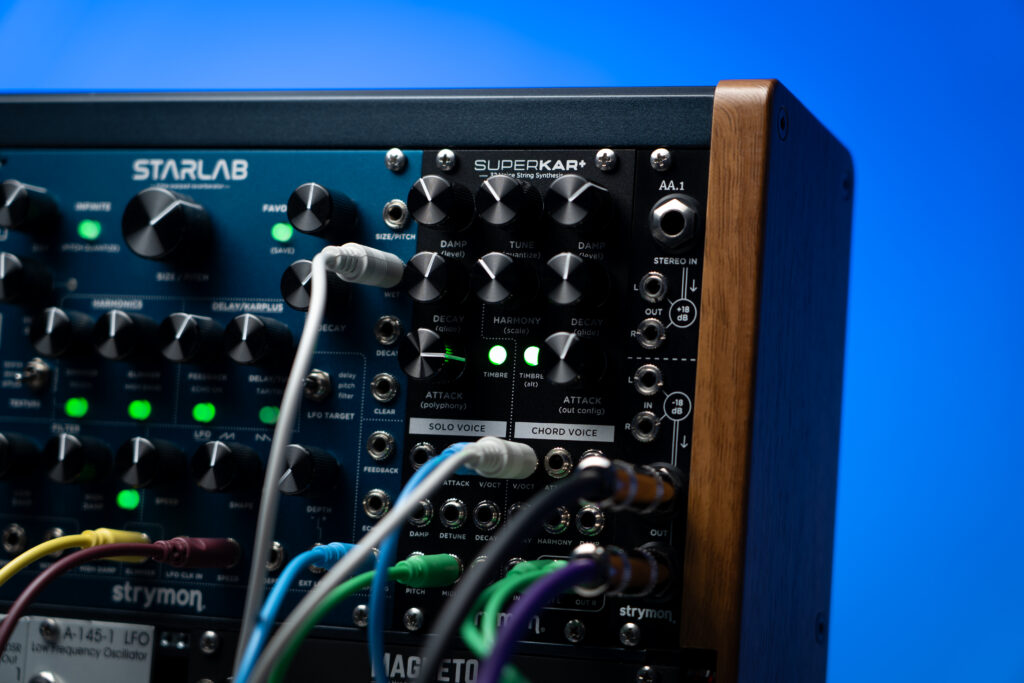
The nature of Karplus-Strong synthesis means that you won’t need to dedicate VCAs or amplifier envelopes to SuperKar+. Independent attack, decay and damping are included for both the Solo and Chord voices, and the module also includes an internal mixer with independent output levels for both voices, as well as multiple stereo and mono audio output modes.
SuperKar+ is divided into two halves or voices: a Solo Voice and a Chord Voice, both of which can be played simultaneously and independently of each other if desired. Both voices can be triggered and pitched independently via control voltage, while the Solo Voice can also be controlled polyphonically via MIDI.
Independent timbre selections are available for both voices, and each voice has its own independent level control and can be routed through a separate audio output if desired.
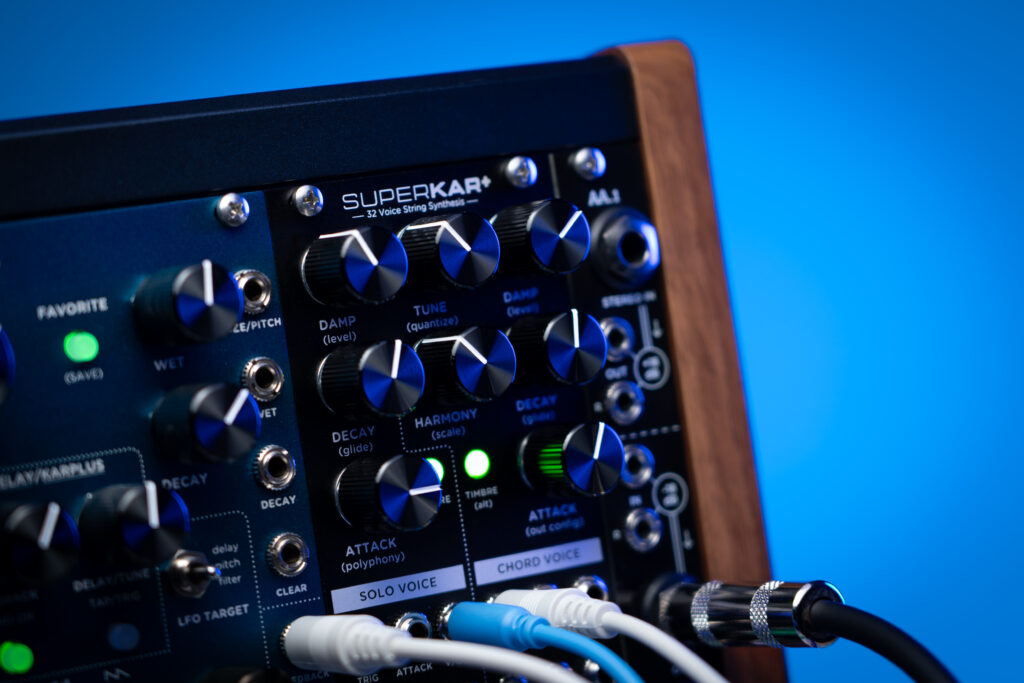


Karplus-Strong Synthesis
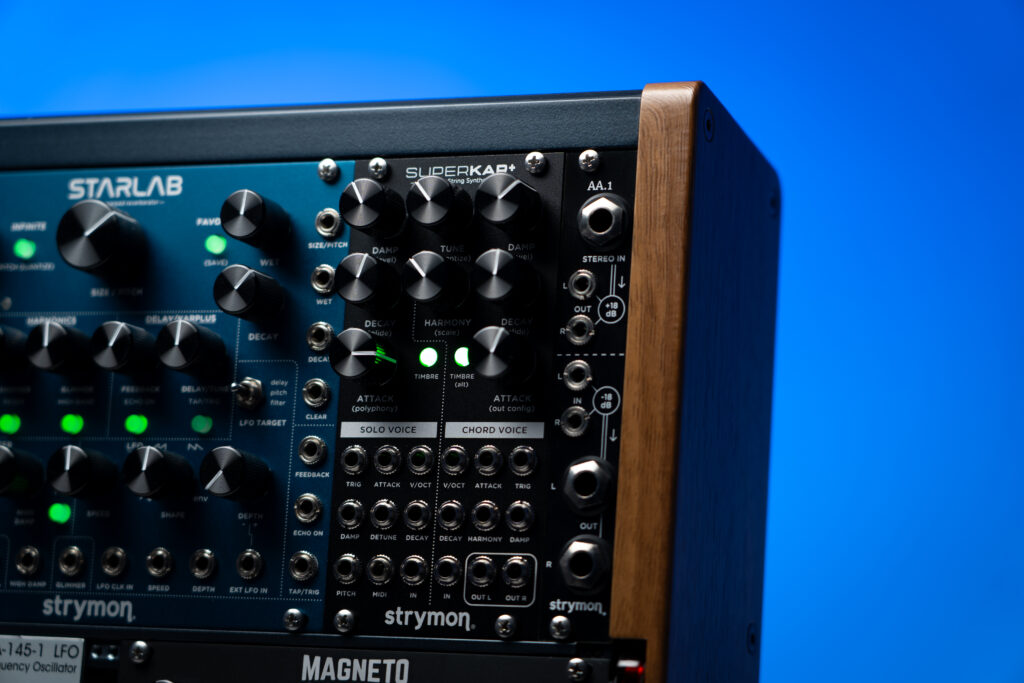
When senior DSP engineer and Strymon co-founder Pete Celi finished tuning the monophonic Karplus-Strong voice in our StarLab Experimental Reverb module a few years ago, he immediately started thinking about how to build a standalone polyphonic instrument.
But what exactly is Karplus-Strong synthesis? Simply put, a very short delay line with high feedback is excited by a sharp transient or burst of noise to produce a pitched sound, which is very similar to the principle of plucking a string. Longer excitations can create bowed string sounds, and when the polarity of the feedback structure is reversed a pipe or tube-like timbre can be produced instead. In SuperKar+ this method of synthesis almost seems to be alive, responding dramatically to slight changes in attack and decay times as well as damping (high frequency filtering that can dampen the string or pipe’s vibration almost like a palm mute). Even clay drum textures can be found with certain settings.
From Brightly Ringing To Palm Muted
The Damp control is more than just a filter—it’s part of the delay feedback structure, affecting how freely the string or tube can vibrate. In combination with the Decay control it can produce anything from bright ringing textures to darker sounds with deep, resonant bass, extending even to palm-muted effects. CV control of the Damp parameter can create very lifelike and nearly human-performed sounds.
Play The Feedback
Coupled with a short Attack time, the Decay control allows you to create super short and tight percussive sounds near its minimum setting. Sounds ring out freely at higher settings, and tuned self-oscillation is possible near the maximum setting. The interaction between Damp, Decay and Attack can create an infinite variety of intriguing results, and all three are controllable via both knob and CV.
Attack of the Tones
Unlike traditional ADSR amplitude envelopes where a longer attack time means that a note takes significantly longer to fade in, with SuperKar+, longer attack times can produce bowed or blown sounds, ranging from short strokes to more sustained bowing/blowing. Very short attack times create plucked or struck sounds. Like the Damp and Decay parameters, you can control the Attack time via knob or control voltage, with the knob acting as an offset for the CV input.
Solo Voice Detune
Available via CV input, the Detune feature on the Solo Voice allows for random detuning for every note that is played. This can take string-like timbres to a whole new level of realism, or add additional movement or even a haunting aspect to a patch.
A Tale of Two Timbres
At the push of a button, SuperKar+ allows you to choose an independent timbre for each voice. The green LED denotes positive feedback for string-based sounds, and the red LED denotes negative feedback for hollow-tube-based sounds.
Portamento To The People
You can use the variable Glide setting to slow down the transition between pitch changes, with the effect being more noticeable and pronounced the further away the notes are from one another in pitch.
Doubling, Octaves, Smart Harmonies And More
With the Harmony control you can create fat doubled notes, lower and higher octave and fifth harmonies, or choose from a selection of smart harmonies that can create advanced and expansive chords in conjunction with the Scale selection.
Even though the Voices are labeled “Solo” and “Chord,” you can easily play chords with the Solo Voice via MIDI while using the Chord Voice to create basslines with doubling or lower octave harmonies. You’re only limited by your imagination.
You can even create a unique tremolo-like effect by applying an LFO to the Harmony CV input, where instead of varying the amplitude, the number of harmony extensions is increased or decreased.
Super Scale+
When a smart harmony is selected via the Harmony parameter, the Scale setting influences the flavor of the chords that will be produced. Choose from: Harmonic Minor, Aeolian, Major, Expanded Voicing Major Scale (for harmonies spaced further away from the root), Dorian, Lydian, Phrygian, or All Major Chords.
Solo Voice Pitch
Connect an LFO to the Solo Voice Pitch CV input to create vibrato or trills, or connect an envelope for envelope-based pitch effects. You can also use this input for offsetting the pitch by a fixed amount. The range of the Pitch CV input is +/- 1 octave.
Wide Stereo, Independent Processing, and More
SuperKar+ is capable of creating a strikingly expansive stereo image. For both of its two stereo output modes, the Chord Voice creates the same type of satisfying stereo image based on the number of harmonies being used. The Solo Voice behaves differently, however.
For both stereo modes, if the Solo Voice has the polyphony set to 1, Solo Voice notes will be heard in the center of the stereo image. Once Solo Voice polyphony is raised to two or more voices, alternating voices will be panned left and right in the stereo image. In Wide Stereo mode, they are panned hard left and right, and in Narrow Stereo mode they are panned near 10 o’clock and 2 o’clock.
But that’s not all: SuperKar+ has two additional output modes for increased flexibility. Split Outputs mode sends the Solo Voice to OUT L and the Chord Voice to OUT R, so that you can process each signal separately. Mono Sum mode sends the same mono mixed output of both voices through both outputs, allowing you to send the same mix to multiple destinations.
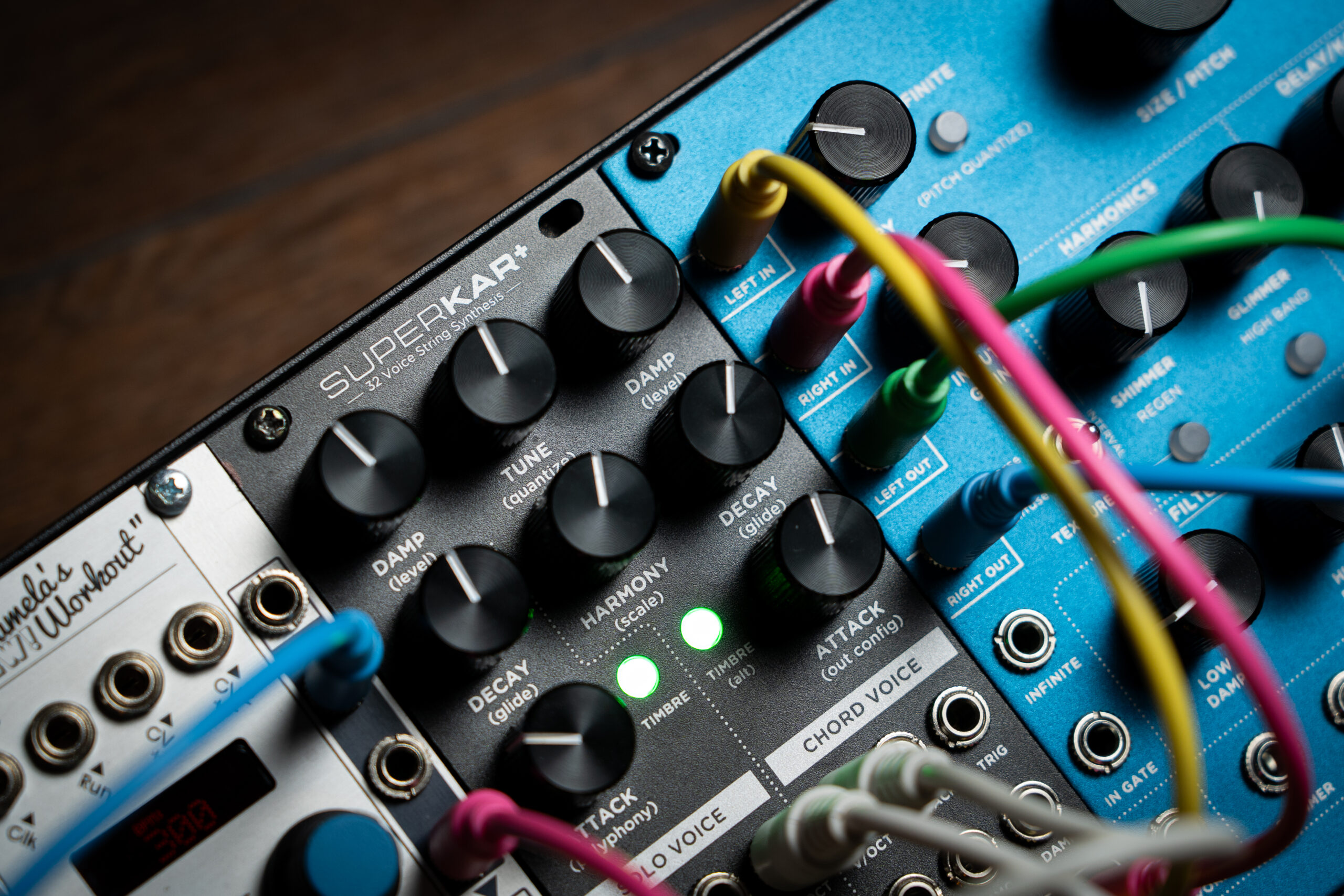
Use the interactive dots (+) to learn more about SuperKar+’s knobs, buttons, and connections.
Primary functions are labeled in CAPS and can adjust the Solo and Chord Voices individually. Secondary functions are labeled in parentheses on each control. Access the secondary functions by pressing and holding the TIMBRE (alt) button and turning the desired knob.

DAMP
Adjusts the high frequency damping within the string vibrations for the respective voice.
(level): Adjusts output level for the respective voice.
DAMP
Adjusts the high frequency damping within the string vibrations for the respective voice.
(level): Adjusts output level for the respective voice.
DECAY
Adjusts the string sustain for the respective voice.
(glide): Adjusts the portamento effect for the respective voice.
DECAY
Adjusts the string sustain for the respective voice.
(glide): Adjusts the portamento effect for the respective voice.
ATTACK
Varies the string attack from a sharp strike to a soft bow (or “breath” in alternate Timbre) for the respective voice.
(polyphony): Sets the number of Solo Voices that will sustain simultaneously, from 1 to 16.
ATTACK
Varies the string attack from a sharp strike to a soft bow (or “breath” in alternate Timbre) for the respective voice.
(out config): Offers the following functions depending on the knob position.
• Minimum: A wide stereo mix (the Solo Voice signal is hard-panned Left/Right for alternating voices, and the Chord Voice tones are heard in stereo).
• 10 o'clock: A narrow stereo mix (the Solo Voice is softpanned Left/Right for alternating voices, and the Chord Voice tones are heard in stereo).
• 2 o'clock: Split outputs (the Solo Voice is heard on OUT L and the Chord Voice on OUT R).
• Maximum: Both Voice signals are summed to mono, and the mono signal is routed to both OUT L and OUT R.
TUNE
Varies the output pitch range over one octave.
(quantize): From minimum to 12 o'clock, selects continuous TUNE adjustment. From 12 o'clock to maximum, quantizes to half steps.
HARMONY
Selects fifteen harmony settings across the knob range. The left TIMBRE button LED will briefly flash off and then on again when a new harmony is selected.
(scale): Selects eight different scale types across the knob range.
Refer to the full user manual for a list of possible harmonies and scales.
TIMBRE
These two switches select the feedback polarity to alter the timbre of the string:
• The left TIMBRE button controls the Solo Voice. Press and hold to access tertiary functions (see the next section).
• The right TIMBRE controls the Chord Voice.
• Green LED denotes positive feedback for string-based sounds, and red LED denotes negative feedback for hollowtube-based sounds.
(alt): Press and hold the right TIMBRE button to access the secondary functions.
TRIG
Rising edge trigger. 0V to +5 V.
ATTACK
Continuous control of the attack. The Solo Voice's ATTACK knob acts as an offset. -5V to +5V.
V/OCT
C0 = 0V, 1V/Octave, six octave range. 0V to +6V.
DAMP
Continuous control. The DAMP knob acts as an offset. -5V to +5V.
DECAY
Continuous control. The DECAY knob acts as an offset. -5V to +5V.
DETUNE
Adds random tuning errors on note trigger corresponding to the CV value: 0V = perfect tuning, 5V = randomly out of tune max. 0V to +5V.
PITCH
Changes the pitch of the note by +/- 1 octave, useful for vibrato, trills, hammer-on effects, or offsetting the pitch by a fixed amount. -5V to +5V.
MIDI
For MIDI control of the Solo Voice, eight octaves available via MIDI. Set the (polyphony) secondary function to maximum for a 16 voice polyphonic MIDI sound module.
IN
20 Vpp maximum. Audio is fed directly to the Solo Voice channel strings, in parallel with the trigger input, to allow for audio excitation of the string(s) or to use SuperKar+ as a sympathetic resonator array. Best results are obtained with the (polyphony) secondary function set to minimum.
V/OCT
C0 = 0V, 1V/Octave, five octaves of chord root, quantized to nearest half step for maximum stability. 0V to +5V.
ATTACK
Continuous control. The Chord Voice's ATTACK knob acts as an offset. -5V to +5V.
TRIG
Rising edge trigger. 0V to +5 V.
DECAY
Continuous control. The DECAY knob acts as an offset. -5V to +5V.
DAMP
Continuous control. The DAMP knob acts as an offset. -5V to +5V.
HARMONY
Continuous control. The Chord Voice's HARMONY knob acts as an offset. Sweeps Harmony through 2nd half of knob, increasing and decreasing number of smart harmony voices. -5V to +5V.
IN
20 Vpp maximum. Audio is fed directly to the Chord Voice channel strings, in parallel with the trigger input, to allow for audio excitation of the string(s) or to use SuperKar+ as a sympathetic resonator array.
OUT L and OUT R
The left and right outputs. Use the (out config) secondary function to select the desired stereo or mono output. The output level is 17.5 Vpp maximum.